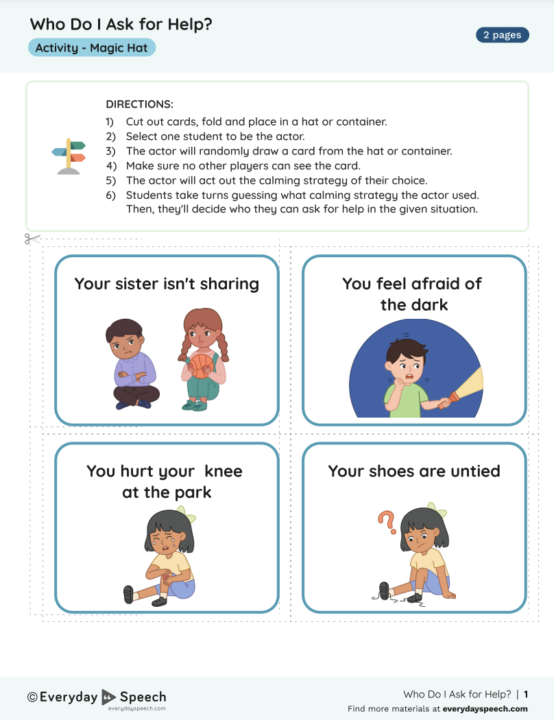
Teaching preschoolers how to ask for help is a critical life skill that builds confidence, promotes independence, and supports emotional well-being. Everyday Speech offers a creative and interactive activity called “Who Do I Ask for Help?” designed to help young children understand who they can turn to when they need assistance. This blog post will explore how preschool teachers can use this activity to teach students how to recognize situations where help is needed and who to approach for that help.
Why Teaching Preschoolers to Ask for Help Matters
Helping preschoolers learn to ask for help is important because it:
- Encourages Independence: Children learn to assess situations and seek help proactively.
- Builds Confidence: Knowing they have support when needed fosters a sense of security.
- Improves Communication: Teaches children to express their needs.
- Supports Emotional Development: Reduces feelings of frustration or fear by ensuring children know they have access to assistance.
Introducing the “Who Do I Ask for Help?” Activity
The “Who Do I Ask for Help?” activity is a hands-on, interactive lesson that uses role-playing and visual aids to teach children how to seek help in different situations. The activity involves acting out various scenarios, guessing strategies, and identifying the right person to ask for help.

Activity Instructions
Here are the detailed instructions for implementing the activity:
- Cut out the cards: Print and cut out the scenario cards provided in the worksheet. These cards depict common situations where a child might need help, such as a sister not sharing or feeling afraid of the dark.
- Place cards in a hat or container: Fold the cards and place them in a hat or container, making them easy to draw.
- Select an actor: Choose one student to be the actor for the first round. This student will draw a card from the hat and act out the scenario depicted.
- Act out a calming strategy: The actor will choose a calming strategy (e.g., deep breathing, counting to ten) and act it out without revealing the situation.
- Guess the strategy: The other students take turns guessing what calming strategy was used by the actor.
- Identify who to ask for help: After guessing, students discuss who they can ask for help in the given situation. This could include a teacher, a family member, or a trusted peer.
Implementing the Lesson in the Classroom
Objective
By the end of the lesson, students will understand different situations where they may need help, learn to apply calming strategies, and identify the appropriate person to ask for help.
Materials Needed
- Printed and cut-out scenario cards from the “Who Do I Ask for Help?” activity (or play digitally)
- A hat or container for drawing cards
- A space for acting out scenarios
- Visual aids or posters that display calming strategies
Duration
30-45 minutes
Activity Steps
1. Introduction to the Concept of Asking for Help (5 minutes)
Start by explaining to the students why it’s important to ask for help when they need it. Discuss common situations where they might need assistance, such as tying their shoes, finding a lost item, or dealing with a scraped knee.
Discussion Points:
- What does it mean to ask for help?
- Why is it important to ask for help when you need it?
- Who are some people you can ask for help?
2. Demonstrating Calming Strategies (5 minutes)
Introduce and demonstrate a few simple calming strategies that children can use when they are upset or unsure about a situation. This might include taking deep breaths, counting to ten, or hugging a stuffed animal.
Example Calming Strategies:
- Deep Breathing: Inhale deeply through the nose, hold for a few seconds, and exhale slowly through the mouth.
- Counting to Ten: Count slowly from one to ten to help calm down.
- Hugging a Toy: Hug a favorite stuffed animal for comfort.
3. Role-Playing Scenarios (15 minutes)
Move on to the role-playing part of the activity. Select one student to draw a card from the hat and act out the scenario using a calming strategy. After the acting, encourage the other students to guess which strategy was used.
Example Scenarios:
- Your sister isn’t sharing: The actor might pretend to calm down by taking deep breaths before asking the teacher for help.
- You feel afraid of the dark: The actor could count to ten and then decide to ask a parent or older sibling for help.
- You hurt your knee at the park: The actor might hug a toy and then decide to ask a nearby adult for assistance.
Benefits:
- Hands-On Learning: Role-playing makes the lesson interactive and engaging.
- Encourages Empathy: By acting out different scenarios, children learn to empathize with others who may need help.
4. Group Discussion on Who to Ask for Help (10 minutes)
After each role-play, lead a group discussion to talk about who the students could ask for help in each scenario. Reinforce the idea that there are always trusted adults and peers who can offer assistance.
Discussion Questions:
- Who could you ask for help in this situation?
- Why is it important to ask for help from this person?
- How did using the calming strategy help before asking for help?
5. Reflection and Reinforcement (5 minutes)
End the lesson with a brief reflection. Ask students to share what they learned about asking for help and how they feel about using the calming strategies. Encourage them to practice these skills whenever they feel unsure or need assistance.
Unlock ALL of our preschool materials by signing up for your free trial today – no credit card required!
Access the full Social Communication Curriculum HERE!
Instant access to thousands of no-prep social skills activities, over 1000+ video lessons, and engaging games designed to enhance learning and development.
Conclusion
Teaching preschoolers to ask for help is an essential life skill that supports their independence, confidence, and emotional well-being. Everyday Speech’s “Who Do I Ask for Help?” activity provides a fun and interactive way to help children understand when and how to seek assistance. By following the steps outlined in this blog post, preschool teachers can create a supportive learning environment where students feel empowered to ask for help when they need it. For more resources and tips on teaching essential life skills to young learners, stay tuned to our blog.
Sample Video
Students learn best from watching real students their own age model skills. Try out this sample video lesson. We offer our entire Social-Emotional Learning platform free for 14 days here!
Related Blog Posts:
Everyday Speech Pre-K Materials Are Here!
Fun and Engaging Social Skills Activities for Preschoolers
Free Preschool Self-Regulation Skills Material

